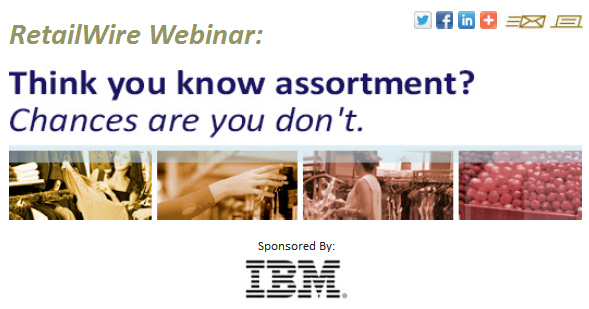WHEN THE GOOD FOLKS at DemandTec asked me to commence writing a series of short commentary pieces on this blog, I accepted the assignment in large measure because the company’s story is a reflection of the story of merchandising analytics in all its facets.
Like DemandTec, an IBM Company, my history as an analyst in what used to be called the “price optimization” sector dates back more than a decade. In 2002 I was asked to try to make this very powerful new retail science more accessible by explaining its benefits and justification in terms other than technical. Price optimization was a new idea, and its target purchasers were wary of its mysterious mechanisms.
Retailers’ objections about the apparent “black box” nature of base price elasticity permeated the sales cycles of industry pioneers, DemandTec’s included. Prospects worried that using computers to model price elasticity and interaction effects to maximize margins was too manipulative. What kind of push-back would they face if shoppers found out?
It took some effort at first, but we correctly reasoned that since optimization is based on measurements of shopper response, it is inherently shopper-centric in nature. Overall, the process tends to deliver more consistent competitive value to shoppers, while retailers maintain sustainable gross margins. These ideas are familiar now, but they were new territory ten years ago.
At about the same time, other pioneers began applying the principles of optimization to other complex merchandising decision processes, notably to the depth and timing of markdowns, and the terms of in-store promotions. Other folks were advancing assortment and space planning tools from the category management side of the house. Pretty soon, it dawned on the smarter people that that the interconnectivity and interaction effects they observed within each of these areas of discipline also exist across these areas of discipline; and not just within the retail organization, but between it and its trading partners.
A simple example might arise when a lower everyday price for a popular item revs up its turnover rate. The existing number of facings may become insufficient, creating intermittent out-of-stocks. The lost sales may tend to distort apparent demand and delay re-orders, and the problem perpetuates. Fold in other concurrent events within the category, such as new item cut-ins and shelf capacity constraints and the problem grows very knotty indeed.
Fly by Wire
When I was first learning about all this, someone I respect explained to me why the mathematical model behind pricing optimization is related to the intricate “fly-by-wire” flight control systems that keep stealth aircraft from dropping out of the sky. Both critical objectives – keeping thousands of interrelated SKUs properly tuned, and keeping multiple interrelated flight surfaces properly tuned – share several traits:
- The model is big
- The model must be dynamic and continuous
- The model must be highly reliable under duress
- The model must be continuously updated at a time cycle that is rapid enough to support critical decision-making
- The model must be appropriately accessible to decision makers
In one respect, those flight control systems may be simpler than retail demand models – there’s only one cockpit in an aircraft. A retail organization, by comparison, may have dozens or hundreds of individual decision makers and planners and trading partners interacting with the merchandising model through various dashboards. Each needs appropriate analytics and decision support according to his or her role.
To the Cloud
As DemandTec developed and acquired its portfolio of software offerings over the past ten years, it placed evident emphasis on connecting users with the data and with each other in practical and beneficial ways. It was an early advocate of the software as a service (SaaS) application business model, which placed the heavy application power in outside computer servers, relieving clients from the burden of maintaining these systems in-house.
Lately the tech industry tends to refer to service-based computing as “the cloud.” In fact DemandTec’s current positioning, “The Collaborative Analytics Cloud,” reflects that. The explosive growth of major social networks has reinforced this concept, as have some of the largest IT companies. IBM, which acquired DemandTec last February, uses the tagline, “Smarter Commerce on Cloud” to describe its core strategic approach.
The company’s DemandTec Connect™ social layer is a recent development in this regard. The platform leverages social-media-like interaction with embedded analytical applications to help shape collaboration across the merchandising ecosystem. Like any social media network, the platform is cloud-based. Its ability to provide role-appropriate access to a variety of optimization analytics is pure DemandTec.
© Copyright 2012 James Tenser
This article was commissioned by DemandTec Inc. which is granted the right of republication. All other rights reserved.


 I WAS ASKED RECENTLY to address a group of consumer products managers about the possible future of Category Management.
I WAS ASKED RECENTLY to address a group of consumer products managers about the possible future of Category Management.
